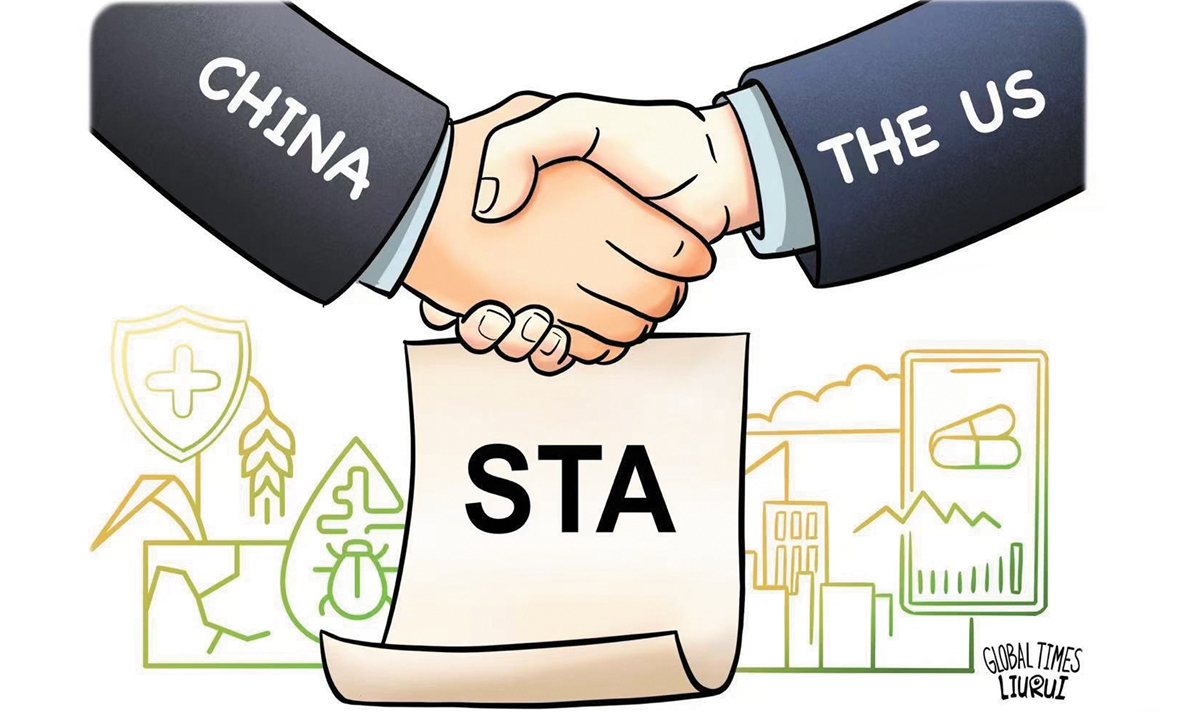
Illustration: Liu Rui/GT
The five-year renewal of the China-US Science and Technology Cooperation Agreement (STA) injects a much-needed ray of hope into the bilateral relationship, charting a path toward the effective management of disputes and risks through the promotion of collaboration.
Amid escalating geopolitical tensions, economic decoupling and fierce competition in high-tech sectors, this agreement serves as a significant reminder that even in rivalry, cooperation remains both possible and necessary.
While the agreement is narrower in scope than its earlier iterations, it offers a pragmatic way forward for both nations to continue working together on critical global challenges.
More importantly, it provides a potential framework for future collaboration and a chance to reshape the trajectory of the bilateral relationship.
The renewal of the STA is undoubtedly a bright spot in the otherwise downward trajectory of China-US relations. This agreement has served as a foundation for scientific collaboration between the two countries for decades, facilitating cooperation in climate research, earthquake monitoring and public health.
However, in recent years, the overall relationship has been marked by growing distrust, with Washington viewing China more as a strategic competitor and a challenger to its national security.
Against this backdrop, the renewal of the STA demonstrates that, despite their differences, the two nations recognize the importance of maintaining a channel for dialogue and collaboration in science and technology.
It reflects a shared understanding that specific challenges - climate change, global pandemics and natural disasters - are too significant for any country to address alone.
By cooperating in these areas, China and the US are sending a clear message: They remain committed to addressing pressing global issues.
Unlike earlier versions, the new agreement is more focused and limited in scope. It emphasizes basic research while excluding sensitive areas such as artificial intelligence and semiconductor technologies. This narrower focus is a pragmatic response to the current geopolitical realities, where concerns over national security and technological competition dominate Washington's agenda.
This shift represents a new model for cooperation - one that prioritizes shared interests in non-sensitive areas while carefully managing risks. By concentrating on global challenges and basic scientific research, the agreement avoids contentious issues while allowing for meaningful collaboration. This approach could serve as a template for future cooperation in science and other areas where mutual benefits outweigh the risks.
Another essential feature of the renewed agreement is the inclusion of mechanisms to ensure data transparency and researcher safety. These measures aim to build trust and ensure that both sides benefit equally from the collaboration. If implemented effectively, they could help address longstanding concerns about data sharing and intellectual property, paving the way for deeper and more sustainable cooperation.
For China, the renewal of the STA is not just an opportunity to continue scientific collaboration; it is also a chance to play a more active role in shaping the bilateral relationship. As China's scientific capabilities have grown, the country has transitioned from being a recipient of knowledge and technology to a key contributor to global science. This shift has made China an indispensable partner in addressing global challenges, from climate change to public health.
By actively participating in and contributing to the agreement, China can demonstrate its commitment to openness and international cooperation.
Furthermore, by delivering tangible results through scientific collaboration, China can showcase its ability to contribute to the global good and build trust with its American counterparts.
The agreement also offers China a platform to accumulate trust and goodwill, which could extend beyond the realm of science.
Despite its potential, the renewed STA faces challenges. The overall China-US relationship remains fraught with tension, and scientific cooperation alone cannot resolve the deep-seated mistrust between the two nations. Political interference, concerns over national security and fears of technology transfer will continue to limit the scope of collaboration, particularly in high-tech and strategic sectors.
Nevertheless, the agreement represents a step in the right direction. It provides a rare example of how China and the US can find common ground and work together, even in an era of strategic competition.




